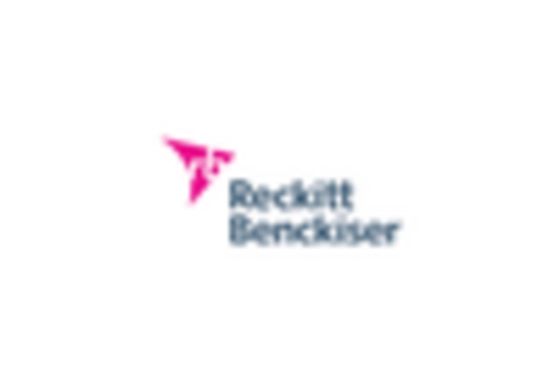Increasing Birth Rates
The Standard Milk Formula Market Industry is experiencing a notable increase in demand due to rising birth rates in various regions. This trend is particularly evident in developing countries, where improved healthcare and living conditions contribute to higher fertility rates. According to recent data, certain regions have reported a birth rate increase of approximately 2.5 percent annually. This demographic shift is likely to drive the demand for infant nutrition products, including standard milk formulas, as parents seek reliable and nutritious feeding options for their newborns. Consequently, manufacturers in the Standard Milk Formula Market Industry are expected to expand their product lines to cater to this growing consumer base, potentially leading to increased competition and innovation in the sector.
Rising Disposable Income
The rise in disposable income among consumers is significantly impacting the Standard Milk Formula Market Industry. As families experience increased financial stability, they are more inclined to invest in premium infant nutrition products. This trend is particularly pronounced in urban areas, where higher income levels correlate with a greater willingness to spend on quality food products for infants. Market data suggests that the premium segment of the standard milk formula market is expected to grow by approximately 7 percent annually, driven by this increase in disposable income. Consequently, manufacturers are likely to focus on developing high-end products that offer enhanced nutritional benefits, thereby catering to the evolving preferences of affluent consumers in the Standard Milk Formula Market Industry.
Expansion of Retail Channels
The expansion of retail channels is a pivotal driver for the Standard Milk Formula Market Industry. With the proliferation of supermarkets, hypermarkets, and online platforms, consumers now have greater access to a wide range of standard milk formula products. This increased availability is likely to boost sales, as parents can conveniently purchase their preferred brands and formulations. Additionally, the rise of e-commerce has transformed the shopping experience, allowing consumers to compare products and prices easily. Recent statistics indicate that online sales of infant nutrition products have surged by over 15 percent in the past year. This trend suggests that the Standard Milk Formula Market Industry will continue to evolve, with retailers adapting their strategies to meet the changing shopping habits of consumers.
Growing Awareness of Infant Nutrition
There is a burgeoning awareness among parents regarding the importance of infant nutrition, which significantly influences the Standard Milk Formula Market Industry. Parents are increasingly educated about the nutritional needs of their infants, leading to a shift towards premium and specialized formulas that cater to specific dietary requirements. This trend is supported by various health organizations advocating for optimal nutrition during the early stages of life. As a result, the market for standard milk formulas is projected to grow, with an estimated increase of 5 percent in sales over the next few years. This heightened awareness is likely to encourage manufacturers to invest in research and development, thereby enhancing the quality and variety of products available in the Standard Milk Formula Market Industry.
Technological Advancements in Production
Technological advancements in production processes are playing a crucial role in shaping the Standard Milk Formula Market Industry. Innovations such as improved processing techniques and enhanced quality control measures are enabling manufacturers to produce high-quality formulas that meet stringent safety and nutritional standards. These advancements not only enhance product quality but also increase production efficiency, allowing companies to meet the rising demand for standard milk formulas. Furthermore, the integration of automation and data analytics in manufacturing processes is expected to streamline operations, reduce costs, and improve supply chain management. As a result, the Standard Milk Formula Market Industry is likely to witness a surge in new product launches, catering to diverse consumer preferences and dietary needs.

















Leave a Comment